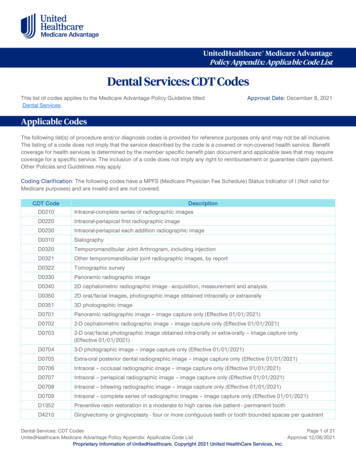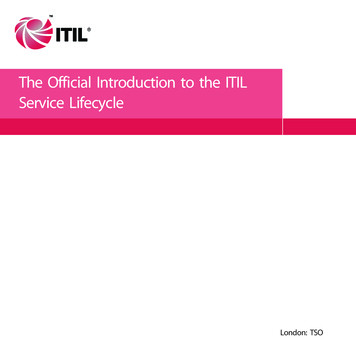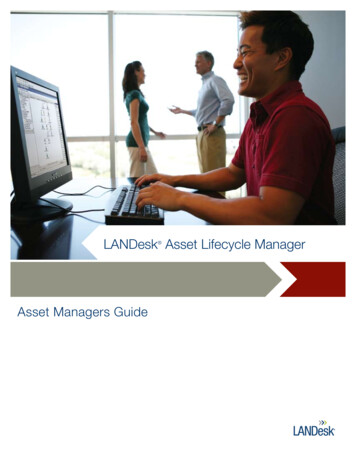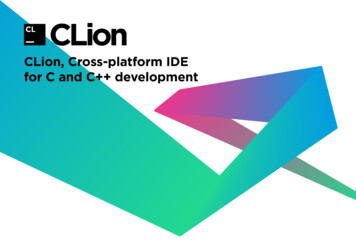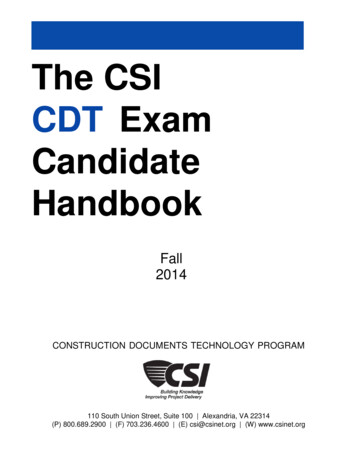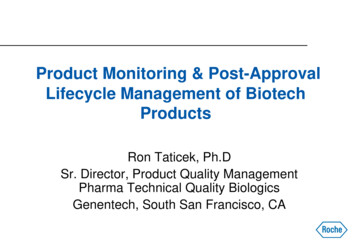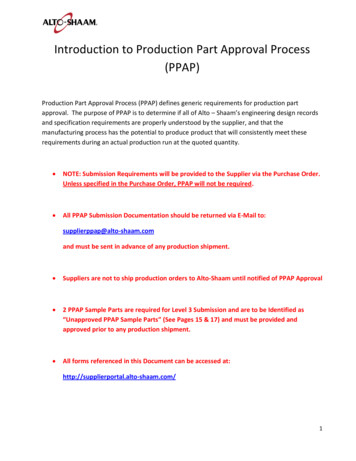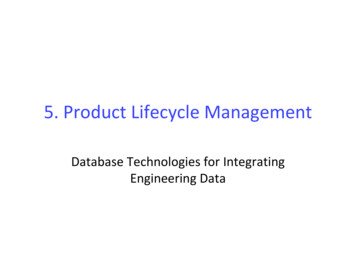
Transcription
Project Approval Lifecycle Training –Stage 4Office of Statewide Project DeliveryCA Department of Technology
CA-PMO Pink SheetCreate Your Own Job AidCapture ideas for follow-up. Use a bright sheet of paper to jotdown key information.I will use this:Look this up later:My reference list:Tools and informationI can use right away.Concepts I want toexplore later on my own.References I want tokeep for future use.2
What Will Be Covered Today This training covers– PAL’s role in IT Project Delivery– Role of “Critical Partners” and “Core Team” inPAL– Stage 4 Preliminary Assessment– Stage 4 Project Readiness and Approval– Transition to Oversight This training will not address– General Business Analysis Techniques– Procurement Training– Analysis of your specific project situation3
Additional Training Business Analysis– Business Analysis Body of Knowledge (BABOK)-basedtraining programs Procurement– Department of General Services, California Procurement &Contracting Academy (Cal-PCA) Project Management– California Project Management Framework (CA-PMF)– Project Management Body of Knowledge (PMBOK)4
Up First This training covers– PAL’s role in IT Project Delivery– Role of “Critical Partners” and “Core Team” inPAL– Stage 4 Preliminary Assessment– Stage 4 Project Readiness and Approval This training will not address––––General Business Analysis TechniquesProcurement TrainingAnalysis of your specific project situationProject Management5
Top Issues Departments Face Contract management and vendor negotiationsData conversion and migrationGovernance and sponsorshipInterface planning and implementationOrganizational change managementQuality assurance and quality controlRelease managementRequirements definition and managementRisks and issuesScheduleTestingArchitecture planning6
CA Statewide IT Project Delivery Stage 1 – Business Analysis (Project Concept)– Approval delegated to AIOs (TL 16-08)– 30 Day target for CDT approval Stage 2 – Alternatives Analysis (Project Alternatives) Stage 3 – Solution Development (Procurement Planning) Stage 4 – Project Readiness & Approval (ProjectReadiness)– Recently released (TL 16-07)7
Project Approval Lifecycle8
PAL is FlexibleThe Project Approval Lifecycle is flexible. The Department of General Services (DGS)delegated purchasing authority will impact whatis submitted to the Department of Technology. Conditional approval at a stage gate allows thedepartment to move forward with futureplanning activities with remediation of specifiedrisks occurring later.9
PAL Policies and Forms PAL guidelines and forms are located in the StatewideInformation Management Manual (SIMM):– SIMM 19 Project Approval Lifecycle** Find a PAL Training Library here with the slide deck fromtoday’s presentation, along with PAL samples, examples, andother resources.https://cdt.ca.gov/policy/simm-19/10
Up Next This training covers– PAL’s role in IT Project Delivery– Role of “Critical Partners” and “Core Team” inPAL– Stage 4 Preliminary Assessment– Stage 4 Project Readiness and Approval This training will not address––––General Business Analysis TechniquesProcurement TrainingAnalysis of your specific project situationProject Management11
Stakeholder Involvement is KeyAn important part of the PAL process is ensuringthat all the right stakeholders are involved in theplanning of your project.12
CDT Critical PartnersCalifornia Department ofTechnology (CDT) will involveCritical Partners from acrossthe organization as well asother state control agenciesfor example, Department ofFinance (DOF) andDepartment of GeneralServices (DGS), in the reviewof PAL documents.Departmentof FinanceProjectApprovals &OversightStatewideTechnologyProcurement& DGSEnterpriseArchitectureOffice ideData Center(OTech)13
When to Partner with DGS vs CDT forProject Procurements?1The decision about whetherto partner with DGS or CDT’sStatewide TechnologyProcurement area dependsupon two factors:– Reportability– Procurement costcompared to purchasingauthority214
Your PAL Development TeamThe PAL Development Teamshould include the necessaryresources to address all aspectsof project planning.* May also involve Legal, as in &ProcurementInformationSecurityProjectManagementIT SystemSupport15
Core Team ConceptThe Core Team is a sub-teamof the PAL DevelopmentTeam that will drive thegathering and reporting ofPAL information and analysis.* May also involve Legal, as eTeamInformationSecurityAdmin &ProcurementProjectManagementIT SystemSupport16
Essential PracticesCore Team ConceptIt is important to have the right level ofengagement from the team members.This means having dedicated resourcescommitted to the project. The lack ofactive team engagement is a project risk.Prepare early for transition. DuringStage 4 make Core Team resourceadjustments that prepare the projectfor the transition from planning tosystem development.17
PAL Development TeamProgram Also known as “the business”— is the driver of the business need. Responsible for ensuring that business process needs are met. Develops a program-appropriate strategy for stakeholderinvolvement.Admin & Procurement Keeps track of time and resources. Will be leveraged for understanding department resources. Leads or assists with the development of solicitations for IT goodsand/or services, and managing support contracts.Which Core Teammembers are involved?*ProgramAdmin &Procurement18
PAL Development TeamProject Management An office specializing in running projects and monitoring thedepartment’s IT portfolio.IT System Support The Data custodian organization for the existing or proposedsolution.Information Security Oversees and validates the security and privacy handling ofinformation by the state entity. Ensures security controls are suitable for the informationclassification.Which Core Teammembers are involved?*ProjectManagementIT SystemSupportInformationSecurity19
PAL Development TeamEnterprise Architecture Ensures alignment of business requirements to the proposedsolution development and alignment of solution development tothe architecture and vision of the Enterprise.Budget Office Provides financial information regarding the existing operations Leads the development of the Financial Analysis Worksheets.* If Legal is also involved, they provide consultation and review ofsolicitations and contracts.Which Core Teammembers are involved?*EnterpriseArchitectureBudget20
Why does Stage 4 matter? Update prior project documents Revise planning estimates Establish project baseline21
PAL Stage 4 Process Stage 3 Collaborative Review & Stage 4Kick-Off Meeting Proposal Evaluation Activities– Guided– Self-directed Stage 4 Collaborative Review &Oversight Kick-Off (if applicable) Stage 4 Decision– Funding & Legislative Approval– Contract award– Project approval22
Collaborative Review Objectives Approve proposals with the business case and thebusiness objectives stated in the Stage 1 Provide guidance and/or instruction on key activitiesneeded to conduct contract management Communicate risk mitigation strategies for projectdesign, development, and implementation Communicate and confirm Office of StatewideProject Delivery Oversight role and associated costs Communicate conditions of approval, if approved23
Up Next This training covers– PAL’s role in IT Project Delivery– Role of “Critical Partners” and “Core Team” inPAL– Stage 4 Preliminary Assessment– Stage 4 Project Readiness and Approval This training will not address––––General Business Analysis TechniquesProcurement TrainingAnalysis of your specific project situationProject Management24
Preliminary AssessmentThe purpose of the Project Approval Lifecycle Stage 4Preliminary Assessment is to: Help mitigate project risks during the last stage of PALConfirm Agencies/state entities readiness to proceedEnsure any remaining project management planningneeds are identifiedEnsure project has an adequate funding strategyidentified25
4.1 & 4.2 General Submittal InfoInstructions for the Stage 4 Preliminary Assessment are locatedin SIMM Section 19C.1– Preparation Instructions.26
4.3 Preliminary AssessmentIntent: Assess the Agency/state entity’s readiness to beginproject delivery. This includes an assessment of the Agency/stateentity’s: Solicitation readiness Project readiness Project fundingOutcome: Confirm readiness to complete final components ofproject planning prior to implementation. Confirm readiness toadvertise solicitation, evaluate bids, and award contract, ifapplicable.27
4.3 Preliminary Assessment28
Essential Practices4.3 Preliminary AssessmentReview previous submissions andTrue up. It is the department’sresponsibility to review previousStage submissions for refinementand updates needed beforeresubmission.Budget Office. Be sure to engage theState entity budget office andDepartment of Finance.Be Proactive. During Stage 4, projectshave a closer relationship with criticalpartners. As things change, involvethem as soon as possible.29
Up Next This training covers– PAL’s role in IT Project Delivery– Role of “Critical Partners” and “Core Team” inPAL– Stage 4 Preliminary Assessment– Stage 4 Project Readiness and Approval This training will not address– General Business Analysis Techniques– Procurement Training– Analysis of your specific project situation30
4.4 General & 4.5 Submittal Info.Intent: Identify changes to the Agency/state entity contactinformation, submission type, and changes if applicable.Outcome: Submission information is accurate and up-to-date.31
4.4 General Info and 4.5 SubmittalInfo.32
Essential Practices4.4 General & 4.5 Submittal Info.True up PAL submissions. Previouslyapproved PAL forms should be updatedas further analysis is conducted,uncertainties are cleared, and data usedfor decision-making improves.Highlight. Any new information orchanges should be highlighted or boldtype to indicate a change was made.Revisit any approval conditions andstatus. Agencies will provide a concisenarrative on the status of any approvalconditions and their plan to address anyoutstanding approval conditions.33
4.6 Primary Solicitation ResultsIntent: Document outcomes associated with the primarysolicitation – in particular, the results of the process and theactivities conducted.Outcome: Summary of the results of the solicitation processincluding actual key action dates, addenda, disposition of bidsubmissions, vendor selection, and subcontractor information.34
4.6 Primary Solicitation Results35
Essential Practices4.6 Primary Solicitation ResultsWork with your procurement official.Make sure the document is an accuratereflection of your solicitation process.Communicate changes and true upinformation. Partner with your PALmanager about which project documentsand FAWs to update. This should coincidewith the completion of the Evaluationand Selection Report.36
Review Criteria: Section 4.6 Primary SolicitationResults Are the primary solicitation key action activities, dates,and number of business days correctly reported? Are the Final Bid Respondents and SubcontractorInformation complete and accurate? Does the solicitation document align with theinformation provided in this section?37
4.7 Ancillary Solicitation StatusIntent: Document and align outcomes, including costs,associated with any pending or completed ancillary solicitations.Outcome: Provide the status for any pending or completedancillary solicitations.38
4.7 Ancillary Solicitation Status39
Essential Practices4.7 Ancillary Solicitation StatusCommunicate changes and true upinformation. Partner with your PALmanager about which project documentsand FAWs to update.40
Review Criteria: 4.7 Ancillary ProcurementStatus Are the ancillary procurements identified alignedwith Stage 3 Section 3.6 Procurement Profile andFinancials Analysis Worksheets? Does it align with the needs of the project? Does this align with any conditions on the projectproposal?41
4.8 Contract ManagementIntent: Ensure that all goods/services/products are incompliance with the terms and conditions in the contract andmeet expectations.Outcome: Increased likelihood of project success with propercontract management.42
4.8 Contract Management43
Essential Practices4.8 Contract ManagementContract management activities beginwith assigning a contract manager andonboarding and properly training thecontract management staff early.The State Contract manager isresponsible for administering thecontract and monitoring contractorrequirements, disputes, KeyPerformance Indicators (KPIs), andadherence.The contract management role is criticalfor protecting the State’s IT investment.The contract manager should be activelyinvolved and have knowledgeablebackup resources.44
Review Criteria: 4.8 Contract Management Has a Contract Manager been identified andtrained on responsibilities? Has a date been scheduled for the post-award andkickoff meeting? Has a plan been created and put in place to collectand assess contractor and project performance ona regular basis?45
4.9 Organizational ReadinessIntent: Confirm the readiness of the Agency/state entity to begindesign, development, implementation and project activities inongoing support of the solution.Outcome: Confirm the organization is ready to execute, support,and adopt, the project into their organization.46
4.9 Organizational Readiness47
Essential Practices4.9 Organizational ReadinessDepartment of Technology Tools.Organizational Change Management andBusiness Process ReengineeringFrameworks will be developed andreleased in Summer 2017.Project Org Chart. Ensure alignment withFinancial Analysis Worksheets.Impact. Project team members shouldhave an understanding of how thisproject will impact the entireorganization.48
Review Criteria: 4.9 OrganizationalReadiness Does the test management plan align with theenterprise architecture and information securityneeds of the organization? Is there planning in place to train and shareinformation amongst project team members? Have dedicated resources been identified forbusiness process improvement or reengineeringactivities?49
4.10 Project ReadinessIntent: Identify Agency/state entity’s methodology andreadiness to begin project design, development andimplementation activities.Outcome: Confirm that the project has the necessary processes,methodologies, and staffing in place.50
4.10 Project Readiness51
Essential Practices4.10 Project ReadinessDocument Strategy. IdentifyAgency/state entity’s previousexperience with system development.Document how staff have been trainedor will receive training.Validate Resources. Take steps toensure staff will be available now thatthe project is ready to begin.Service Request. If CDT projectoversight services are required, a CDTService Request must be submitted.52
Review Criteria: 4.10 Project Readiness Does the resource strategy align with the solutiondevelopment methodology? Has the Evaluation and Selection Report beenapproved? If applicable, partner with your Office ofTechnology Services (OTech) representative forplanning purposes.53
4.11 Requirements BaselineIntent: Identify any solution requirement changes as a result ofthe solicitation process and vendor responses.Outcome: Evaluate and understand the impact, properly logrequirement changes, and verify that the solution requirementsstill align with business objectives, as a result of solutionrequirements changes.54
4.11 Requirements Baseline55
Essential Practices4.11 Requirements BaselineReasonableness. Calculate thepercentage of requirement change.Baselining. The requirementsvalidated during Stage 4 are therequirements baseline for the project.56
Review Criteria: 4.11 Requirements Baseline Do the final requirements align with the businessobjectives identified in Stage 1? Have any of the mid-level or detailed solutionrequirements been modified since approval ofStage 3 Solution Development? Can we validate the requirements traceabilityartifacts have been updated?57
4.12 ScheduleIntent: Update the project schedule by identifying high leveldates and project tasks and document the rationale for whychanges have occurred.Outcome: The final baseline schedule for the project.58
4.12 Schedule59
Essential Practices4.12 ScheduleBest Practices for SchedulingValidate your roles and responsibilitiesto make sure scheduled tasks areassigned with appropriately skilledresources.Be complete. The vendor tasks andresources identified in their proposedschedule should be aligned with thehigh level master schedule.Communicate changes and true upinformation. Partner with your PALmanager about which projectdocuments and FAWs to update.60
Review Criteria: 4.12 Schedule Does the high level schedule align with the vendorschedule? Is the high level schedule realistic? Does the project resources align to the schedule?61
4.13 Cost BaselineIntent: Revaluate the cost estimate using vendor bid responses,state resourcing costs and selected vendor costs and documentthe rationale for why changes have occurred.Outcome: The final baseline cost for the project.62
4.13 Cost Baseline63
PAL Funding Strategy64
Financial Analysis Worksheet Process65
Total Project CostIn Stage 4 (after bids are evaluated)My total project costs are equal toor less than my Stage 2 estimates.Action?No Action Necessary.AdminActionProject approvedbased on finalproject cost.ResultAwardcontract.My total project costs are within20% or 5 million (whichever isless) of Stage 2 estimates.Revise PAL deliverables to reflectproject cost changes (may includeupdated budget action for increasedfunding to specific budget years,redirected funds, etc.)Project approvedbased on finalproject cost.Awardcontract.My total project costs exceed 20%or 5 million (whichever is less) ofStage 2 estimates.1. Determine cause of variance andviability of project.2. Negotiate with vendor to reduceproject costs to within 20% or 5million of Stage 2 estimates.3. Revise PAL deliverables to reflectnegotiation results (changes toscope).Project is notapproved and ison hold pendingadditional analysison the project’sviability.Proposal onhold.66
Essential Practices4.13 Cost BaselineValidate the FAWs Ensure they reflectthe planned project activities and anyservices or contracts associated withthe project. Ensure there is analignment between the FAWs and anyBCP action.Total Project Cost. Differencesbetween estimated and actual costsshould include a justification for thechange.67
Review Criteria: 4.13 Cost Baseline What were the cost estimates in Stage 2? What are the baseline final project costs? For differences between your cost estimates andthe baseline final project costs– Provide the rationale– Ensure the BCP is reflective of the final proposal BCP(s) must align to the FAWs68
4.14 Project Management PlanningIntent: Ensure the project management planning is sufficient toeffectively manage the project.Outcome: CDT can gain confidence that the project has thoughtthrough how to effectively manage the project and reduce risk.69
4.14 Project Management Planning70
Essential Practices4.14 Project Management PlanningReminders: Align plans with a project managementframework (e.g. PMBOK, CA-PMF) Make sure the project plans areappropriate for the scope of the project Completion of planning may be acondition of Stage approval.Finish Line. The scalability of yourproject is a component in determiningwhich project plans are required to becompleted prior to project approval.71
Review Criteria: 4.14 Project ManagementPlanning Have the project management plans and artifactsbeen identified? Do the “Not Applicable” plans include a reason whyit is not needed? Do the plans marked “No” include a status?72
4.15 Risk RegisterIntent: All project risks and risk response strategies have beenidentified and are documented.Outcome: Increased likelihood of project success with properrisk management.73
4.15 Risk Register74
Essential Practices4.15 Risk RegisterEnsure your risk register is kept up todate. Use proper project managementpractices when managing your riskprocess.Accountability is key. Assign a singleperson to be accountable for the riskmanagement process.75
Review Criteria: 4.15 Risk Register Is the risk register attached and current? Does it include all project risks continuing intoproject execution?76
Solicitation and PALContractSignedStage 3S3 ApprovalLetterSolicitation isreleased withapproval of Stage 3Stage 4S4 ApprovalLetterAgency reportssolicitation outcomes inStage 4 ProjectReadiness & Approval77
Next Steps Transition to Oversight Per State Administrative Manual Section (SAM) 4819.2,“Project Oversight” is: “An independent review andanalysis to determine if the project is on track to becompleted within the estimated schedule and cost, andwill provide the functionality required by thesponsoring business entity. Project oversight identifiesand quantifies any issues and risks affecting theseproject components.” See SIMM 45 for more information78
IT Project OversightThrough the Office of Statewide Project Delivery(OSPD), the CDT is responsible for the approval andoversight of IT projects, including:-Project Approval Authority-Project Oversight Authority-Analysis and Advice-Oversight Protocol79
80In Flight Project RequirementsDocumentTimeframeProject Status Report (PSR)5th business day of monthIndependent Project OversightReport (IPOR)10th business day of monthSpecial Project Report (SPR)3rd Monday in July (Fall)2nd Monday in January (Spring)Anytime – no budget action
81Closing Project RequirementsDocumentTimeframePost ImplementationEvaluation Report (PIER)Within 18 months ofproject close out
Additional Next Steps Manage the established Project baseline– Completion of Project Status Reports– Special Project Reports (SPR)– Budget requests (post approval, if applicable)– Post Implementation Evaluation Report (PIER)82
What We Covered Today This training covered– PAL’s role in IT Project Delivery– Role of “Critical Partners” and “Core Team” inPAL– Stage 4 Preliminary Assessment– Stage 4 Project Readiness and Approval– Transition to Oversight83
Stage 4 Q&AQuestions?Ask The Exper ts84
Q&AThank You!PA L Tr a i n i n g Te a mContact Us @CIOPALTraining@state.ca.gov85
Appendix 1To o l s & R e s o u r c e s86
Tools & Resources 1Tool NameProject Approval Lifecycleforms and instructions(SIMM 19)IT Project Reporting ProcessFlow (SIMM 10)ReferencesForm SectionNote or LinksAllhttps://cdt.ca.gov/policy/simm-19/AllGate 4 Collaborative ReviewGuidelines (SIMM 19D.6)AllCDT Technology loads/2017/03/SIMM 10 Document Description and Process ttps://cdt.ca.gov/tech-alerts/87
Tools & Resources 2Tool NameReferencesForm SectionNote or LinksStage 4 Project Readinessand Approval Instructions –SIMM 4/D.1-Preparation-Instructions.pdfStage 4 mm-19/Understanding AgileAllCA-PMF Sample e/Link to California Project Management FrameworkTemplates page (including DED & DAD Templates)https://cdt.ca.gov/policy/simm-19/88
Tools & Resources 3Tool NameReferencesForm SectionNote or /07/F.1-PreparationInstructions.pdfSIMM 19F Financial AnalysisWorksheets F.2 - croll down to bottom of page until you locate theresource.State Contracting ManualVolume s/SCM3.aspxSIMM 19F Financial AnalysisWorksheets F.1 –Preparation Instructions89
Tools & Resources 4Tool NameReferencesForm SectionNote or LinksEvaluation and SelectionReport r 4.B5.9Government Code 11545and codes displayText.xhtml?lawCode GOV&division 3.&title 2.&part 1.&chapter 5.6.&article SIMM 17 CA-PMF Templates4.14http://capmf.cio.ca.gov/90
Appendix 2Roles & Responsibilities91
Program Program team members should be Subject MatterExperts (SMEs), in the program areas that have thebusiness need.– This person should know the resources and functions ofthe program, including program policy and processes. Resources the Program person should bring tothe team include:– Procedural manuals– Relevant policy interpretations– A working knowledge of the business process flows92
Administration & Procurement Administration is a broad area that captures a widerange of functions. Common areas that may betapped include:––––AccountingFacilitiesContract ManagementHuman Resources The Administration team members would bringknowledge and resources such as:– Organizational charts– Duty statements– Contract management knowledge93
Administration & Procurement Procurement is a specialized area that capturesfunctions and duties related to:––––Conducting market researchDetermining procurement approachDeveloping solicitationsOverseeing overall procurement activities The procurement team members would bringknowledge and resources such as:––––Market research assistanceProcurement approach optionsCosting modelsEvaluation methodology94
Project Management The Project Management team member isresponsible for:– Documenting the analysis and planning activities that theproject team is doing, including mapping out a schedule– Creating methods and processes to manage the proposaldevelopment and the project CDT expects that a Project Manager be a core teammember from S2AA onward, where organizationalcapacity exists.95
IT System Support IT System Support is the custodian of the existing datasystems.– IT is on the Core Team and at the table, but the Programarea drives the effort. IT System Support team members are responsible for:Serving as SMEs for the technical solutionBringing documentation of the existing systemServing as the liaison with the Statewide Data CenterAssisting in estimating IT related project costs fordevelopment and infrastructure– Maintaining the new solution––––96
Information Security Information Security has both a business andtechnical focus. Information Security– Oversees and validates the security and privacy handlingof information by the state entity.– Ensures security controls are suitable for the informationclassification.97
Enterprise Architecture Enterprise Architecture (EA) focuses on thebusiness and ways technology may be used tomeet business needs. The EA team member is expected to bringknowledge of:–––––The businessBusiness requirementsState entity EA practice and policiesStatewide EA Practice and ProgramAppropriate governance and standards98
Budget Office The Budget Office team member serves as lead inthe development of the Financial AnalysisWorksheets (FAWs) included in PAL Stage 2. The Budget Office team member will bringknowledge of:– State budget processes– Budget timelines– Cost estimation methodologies99
4.8 Contract Management . Contract management activities . begin with assigning a contract manager and onboarding and properly training the contract management staff early. The State Contract manager is responsible . for administering the contract and monitoring contractor requi
